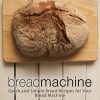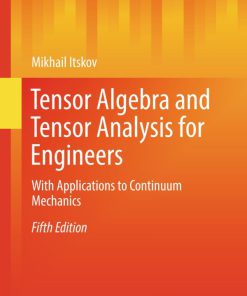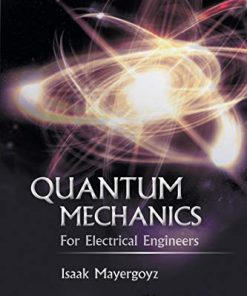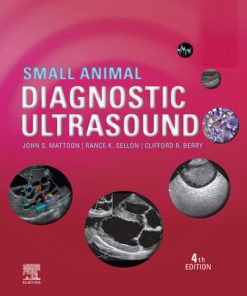Continuum Mechanics for Engineers 4th Edition by Thomas Mase, Ronald E Smelser, Jenn Stroud Rossmann ISBN 9781482238686 1482238683
$50.00 Original price was: $50.00.$25.00Current price is: $25.00.
Continuum Mechanics for Engineers 4th Edition by Thomas Mase, Ronald E Smelser, Jenn Stroud Rossmann – Ebook PDF Instant Download/Delivery: 9781482238686 ,1482238683
Full download Continuum Mechanics for Engineers 4th Edition after payment
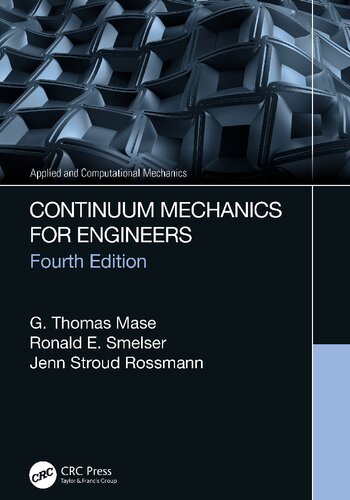
Product details:
ISBN 10: 1482238683
ISBN 13: 9781482238686
Author: Thomas Mase, Ronald E Smelser, Jenn Stroud Rossmann
Continuum Mechanics for Engineers 4th Edition Table of contents:
1. Continuum Theory
1.1 Chapter Learning Outcomes
1.2 Continuum Mechanics
1.3 Starting Over
1.4 Notation
2. Essential Mathematics
2.1 Chapter Learning Outcomes
2.2 Scalars, Vectors and Cartesian Tensors
2.3 Tensor Algebra in Symbolic Notation – Summation Convention
2.3.1 Kronecker Delta
2.3.2 Permutation Symbol
2.3.3 ɛ – δ Identity
2.3.4 Tensor/Vector Algebra
2.4 Indicial Notation
2.5 Matrices and Determinants
2.6 Transformations of Cartesian Tensors
2.7 Principal Values and Principal Directions of Symmetric Second-Order Tensors
2.8 Tensor Fields, Tensor Calculus
2.9 Integral Theorems of Gauss and Stokes
Problems
3. Stress Principles
3.1 Chapter Learning Outcomes
3.2 Body and Surface Forces, Mass Density
3.3 Cauchy Stress Principle
3.4 The Stress Tensor
3.5 Force and Moment Equilibrium; Stress Tensor Symmetry
3.6 Stress Transformation Laws
3.7 Principal Stresses; Principal Stress Directions
3.8 Maximum and Minimum Stress Values
3.9 Mohr’s Circles For Stress
3.10 Plane Stress
3.11 Deviator and Spherical Stress States
3.12 Octahedral Shear Stress
Problems
4. Kinematics of Deformation and Motion
4.1 Chapter Learning Outcomes
4.2 Particles, Configurations, Deformations and Motion
4.3 Material and Spatial Coordinates
4.4 Langrangian and Eulerian Descriptions
4.5 The Displacement Field
4.6 The Material Derivative
4.7 Deformation Gradients, Finite Strain Tensors
4.8 Infinitesimal Deformation Theory
4.9 Compatibility Equations
4.10 Stretch Ratios
4.11 Rotation Tensor, Stretch Tensors
4.12 Velocity Gradient, Rate of Deformation, Vorticity
4.13 Material Derivative of Line Elements, Areas, Volumes
Problems
5. Fundamental Laws and Equations
5.1 Chapter Learning Outcomes
5.2 Material Derivatives of Line, Surface, and Volume Integrals
5.3 Conservation of Mass, Continuity Equation
5.4 Linear Momentum Principle, Equations of Motion
5.5 Piola-Kirchhoff Stress Tensors, Lagrangian Equations of Motion
5.6 Moment of Momentum (Angular Momentum) Principle
5.7 Law of Conservation of Energy, The Energy Equation
5.8 Entropy and the Clausius-Duhem Equation
5.9 The General Balance Law
5.10 Restrictions on Elastic Materials by the Second Law of Thermodynamics
5.11 Invariance
5.12 Restrictions on Constitutive Equations from Invariance
5.13 Constitutive Equations
References
Problems
6. Linear Elasticity
6.1 Chapter Learning Outcomes
6.2 Elasticity, Hooke’s Law, Strain Energy
6.3 Hooke’s Law for Isotropic Media, Elastic Constants
6.4 Elastic Symmetry; Hooke’s Law for Anisotropic Media
6.5 Isotropic Elastostatics and Elastodynamics, Superposition Principle
6.6 Saint-Venant Problem
6.6.1 Extension
6.6.2 Torsion
6.6.3 Pure Bending
6.6.4 Flexure
6.7 Plane Elasticity
6.8 Airy Stress Function
6.9 Linear Thermoelasticity
6.10 Three-Dimensional Elasticity
Problems
7. Classical Fluids
7.1 Chapter Learning Outcomes
7.2 Viscous Stress Tensor, Stokesian, and Newtonian Fluids
7.3 Basic Equations of Viscous Flow, Navier-Stokes Equations
7.4 Specialized Fluids
7.5 Steady Flow, Irrotational Flow, Potential Flow
7.6 The Bernoulli Equation, Kelvin’s Theorem
Problems
8. Nonlinear Elasticity
8.1 Chapter Learning Outcomes
8.2 Nonlinear Elastic Behavior
8.3 Molecular Approach to Rubber Elasticity
8.4 A Strain Energy Theory for Nonlinear Elasticity
8.5 Specific Forms of the Strain Energy
8.6 Exact Solution for an Incompressible, Neo-Hookean Material
References
Problems
9. Linear Viscoelasticity
9.1 Chapter Learning Outcomes
9.2 Viscoelastic Constitutive Equations in Linear Differential Operator Form
9.3 One-Dimensional Theory, Mechanical Models
9.4 Creep and Relaxation
9.5 Superposition Principle, Hereditary Integrals
9.6 Harmonic Loadings, Complex Modulus, and Complex Compliance
9.7 Three-Dimensional Problems, The Correspondence Principle
References
Problems
10. Plasticity
10.1 Chapter Learning Outcomes
10.2 One-Dimensional Deformation
10.3 Modeling Plasticity
10.4 Yield Criteria
10.4.1 Tresca-Coulomb Yield Criterion
10.4.2 von Mises Yield Criterion
10.4.3 Kinematic Hardening Yield Criterion
10.5 Plastic Flow
10.5.1 Tresca-Coulomb Yield Criterion
10.5.2 von Mises Yield Criterion
10.5.3 Kinematic Hardening Yield Criterion
10.6 Plastic Modulus
10.6.1 Isotropic Hardening
10.6.2 Kinematic Hardening
10.7 Elasto-Plastic Constitutive Equations
10.7.1 Prandtl-Reuss (J2) Elasto-Plastic Equations
10.7.2 Levy-Mises Flow Equations
10.7.3 Perfectly Plastic Constitutive Behavior
10.8 Deformation Theory of Plasticity
10.9 Examples
10.9.1 Torsion of a Shaft
10.9.2 Bending of a Beam by a Moment
10.9.3 Thin-Walled Tube Tension and Torsion
References
Problems
Appendix A: General Tensors
A.1 Representation of Vectors in General Bases
A.2 The Dot Product and the Reciprocal Basis
A.3 Components of a Tensor
A.4 Determination of the Base Vectors
A.5 Derivatives of Vectors
A.5.1 Time Derivative of a Vector
A.5.2 Covariant Derivative of a Vector
A.6 Christoffel Symbols
A.6.1 Types of Christoffel Symbols
A.6.2 Calculation of the Christoffel Symbols
A.7 Covariant Derivatives of Tensors
A.8 General Tensor Equations
A.9 General Tensors and Physical Components
References
Appendix B: Viscoelastic Creep and Relaxation
Index
People also search for Continuum Mechanics for Engineers 4th Edition:
continuum mechanics for engineers pdf
continuum mechanics for engineers by g. a. maugin
continuum mechanics for engineers theory and problems
continuum mechanics for engineers 3rd edition pdf
continuum mechanics for engineers solution manual
Tags: Thomas Mase, Ronald E Smelser, Jenn Stroud Rossmann, Continuum Mechanics, Engineers
You may also like…
Physics - Theoretical Physics
Principles of Continuum Mechanics A Basic Course for Physicists Zdeněk Martinec
Mathematics - Algebra
Physics - Mechanics
Classical Continuum Mechanics (Applied and Computational Mechanics) 2nd Edition Surana
Mathematics - Algebra
Medicine - Veterinary Medicine
Small Animal Diagnostic Ultrasound 4th Edition Thomas G. Mattoon
Mathematics - Mathematical Physics

